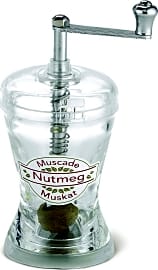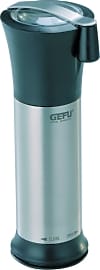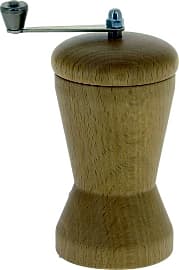The 9 Best Nutmeg Graters

This wiki has been updated 44 times since it was first published in February of 2016. The versatile spice nutmeg has been vaunted since ancient times for its various coveted properties, but because it's nearly as solid as a rock, it can be hard to process. Since fresh-grated spices are almost always better than stale, bottled seasonings, consider a nutmeg grinder to take the hard work out of preparing seeds, nuts, ginger, and more, making it easier than ever to amp up your cooking. When users buy our independently chosen editorial selections, we may earn commissions to help fund the Wiki.
Editor's Notes
February 24, 2021:
Nutmeg is up there with cinnamon and star anise as one of the most difficult seasonings to process, but it doesn't have to be. Because a nutmeg seed is relatively easy to grasp, you can get away with using the Microplane 46016 if you just need small amounts, or the especially versatile Microplane Classic Zester for larger batches. In fact, we'd recommend that classic Microplane be a part of every kitchen, both at home and at work, because it's a remarkably useful tool in a lot of settings.
For less potential danger to your knuckles, and to add some mechanical advantage to the task, there are plenty of mill-style options out there. Unsurprisingly, the Microplane 48060 is commonly regarded as the best, and the Waring Commercial WSG30 ishould be no stranger to experienced cooks. For something a little more aesthetically pleasing, there's the Peugeot Ternate, which has plenty of built-in storage for surplus seeds, the Marlux 316-C that has a classy wooden body, and the Cole & Mason Acrylic, which is transparent, so you can see exactly what's going on inside. And if you really don't want to spend much, you can go with the Norpro 335, but be warned - it takes a significant amount of focus to avoid scraping yourself on this one, although it is quite durable and should last a while.
February 28, 2019:
Removed four products including the William Bounds Mill and Drogheria & Alimentari All Natural due to availability concerns. Several distinct grinding mechanisms are represented in this list to meet the needs of both amateurs and professionals. For high-volume processing, the electric Waring Commercial WSG30 was included. Conversely, home cooks who are looking for a simple way to spice up their morning brew might prefer one of the manual models, such as the Microplane 46016 or Marlux 316-C.
Spicing Things Up: The Nutmeg Grater
If you wish to produce a good deal of greater nutmeg and you also value the aesthetics associated with gourmet food preparation, consider a rotary-style nutmeg mill.
Sourced from trees in the Myristica genus native to islands in the Indian Ocean, the nutmeg seed usually measures about one inch in length and is too tough for any practical use as a whole piece. But grated into a fine powder, nutmeg is nutritious, delicious, and perennial popular, used in a range of cuisines around the world and also prized for its ability to be used in creating essential oils.
As nutmeg has been a popular spice for many centuries now, various methods and tools have long been used to grind the solid nut into a usable powdered form. Nutmeg graters (which were often carried by members of high society in 17th century Europe, fresh nutmeg being a prized addition to the popular punch beverages of the day) consist of little more than a metal surface perforated with sharp rasps. When passed back and forth against the surface of a nutmeg seed, the rasps remove bits of the nutmeg, usually channeling it down a tube-shaped internal column for collection or for direct application to foods or beverages.
A handheld rasp-style nutmeg grater might not be the most elegant tool a chef owns, but in fact it may well be the best possible device for producing ground nutmeg. These simple graters put complete control of the process into the cook's hands, with a person able to regulate the coarseness of the grinds based on pressure applied and to stop grinding the seed precisely as soon as he or she has produced enough powdered nutmeg. On the other hand, such grater also almost fully preclude the complete use of any seed, as a person risks cutting their fingers on the rasps once the seed has grown too small. And while excellent for controlling minute amounts of grated nutmeg, such a tool is also much less efficient than other more mechanically-inclined options when you have large quantities of ground nutmeg to produce.
If you wish to produce a good deal of greater nutmeg and you also value the aesthetics associated with gourmet food preparation, consider a rotary-style nutmeg mill. These tools place a nutmeg seed (or several) in a closed chamber topped by a hand-turned crank usually connected to a group of claws that hold the seed in place and apply downward pressure. When operated, the rotating twists the seed against a series of rasps or teeth, shaving bits of nutmeg with ease.
Finally, there are spice grinders that make the process even easier for you by using an electric motor to provide the torque. These devices lack the aesthetic charm of a hand-operated mill, and they might make it hard to grind precisely the amount of spice needed for a given recipe or beverage topping, but they are unmatched in simplicity of function. As long as you have an airtight jar or another receptacle on hand to store the excess ground nutmeg an electric grater will likely produce, they are a fine choice for any kitchen, cocktail bar, or coffee shop where the spice is routinely used.
The Secret Use of Nutmeg You Don't Know About
Nutmeg, like most spices, is never a central ingredient in any recipe; in fact, it is rarely even meant to define the flavor profile of a given meal or beverage, but rather to add a bit of complexity to the food or drink. Nutmeg is experienced by most palates as sweet and nutty, with enough camphor-like spice to be harsh in large quantities but easily mellowed by foods such as dairy or rice products and balanced by the bright and crisp flavors of citrus fruits.
Beyond its use in the kitchen, nutmeg also has noted benefits when refined into an essential oil.
When most people think of nutmeg, they likely first picture an inviting glass of eggnog served during the holidays spiked with some rum or brandy and topped by grated spices. Nutmeg is a popular topper or addition to myriad beverages beyond eggnog, of course, used in a range of alcoholic punches and in coffee and cocoa drinks. It is also commonly sprinkled over or baked into pies, pastries, and breads, and is an important ingredient in dishes such as Indonesian Oxtail Soup, Middle Eastern Al Kabsa, and Scottish haggis.
Beyond its use in the kitchen, nutmeg also has noted benefits when refined into an essential oil. Achieve through the distillation of ground nutmeg, the oil sourced from nutmeg contains several organic chemicals (mostly terpenoids and phenylpropenes) such as geraniol and safrol. The oil is used in oral hygiene products, cough suppressant medicines, and in tinctures designed to soothe stomach and intestinal issues. It can also be used to invigorate a massage oil or as part of an aromatherapy regimen intended to enhance the relaxation and tranquility of a user.
As nutmeg can have generally undesired side effects when consumed in too great a dose, including indigestion, headache, and even induction of hallucinatory and/or otherwise psychoactive episodes, it is best kept out of reach of children and consumed only in moderation.
The Spicy History of Nutmeg
As mentioned above, nutmeg is native to a number of Indian Ocean islands known, fittingly enough as, the Spice Islands. It was one of many prized and rare spices that were wildly popular in the west during the Middle Ages and Renaissance -- cinnamon, pepper, and cloves were also highly sought after -- both for its culinary uses and for its perceived medicinal characteristics. (It was thought for many centuries that nutmeg and certain other spices could help to prevent infection with the bubonic plague.)
Soon nutmeg was among a number of products commanding such a high price that it helped to change the very balance of the political world.
However the spice's history goes back many hundreds of years before the Medieval period. In fact the use of nutmeg and other spices was popular among ancient civilizations including Rome. The breakdown of the Roman Empire in the first centuries of the Common Era saw a dramatic reduction in global trade, which subsequently meant much less spice imported to the western world.
As trade between Europe and the so-called Orient was reestablished and began to flourish in the late 15th century, so too did the access to an demand for spices reignite. Soon nutmeg was among a number of products commanding such a high price that it helped to change the very balance of the political world. Smaller countries with powerful maritime trading traditions, such as Portugal and The Netherlands, would rise to (relatively brief) global prominence as powerhouses of trade. The Dutch East India Company in particular brought vast amounts of wealth and clout to the peoples of The Netherlands, establishing trade routes, plantations, and waging wars of conquest over natives and against competing European parties.














